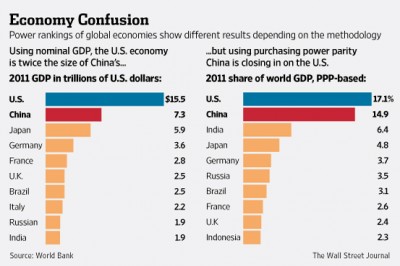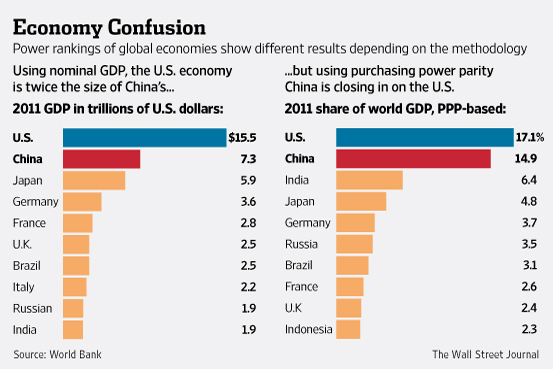
There are a number of reports around Wednesday (here and here) that China’s economy, by one measure at least, is likely to surpass the U.S. in size sometime this year.
The headlines will surprise many people, used to hearing China’s economy will overtake the U.S. sometime in the 2020s, or even later.
On Wednesday, the International Comparison Program, a statistical project coordinated by the World Bank, announced new data on the size of economies by purchasing power parity that suggests China’s economy is bigger than previously thought.
But the latest news is anything but surprising.
Regular GDP power rankings are compiled by converting a country’s gross domestic product into U.S. dollars at market exchange rates. The U.S.’s economy in 2012 was valued at over $16 trillion, twice the size of China’s, according to World Bank statistics. It’s by these measures that China’s economy won’t overtake the U.S. for a decade or more.
Some economists say this way of comparing economies is misleading because it doesn’t take fluctuating exchange rates into account. If you believe China’s yuan currency is undervalued, as U.S. Treasury does, then its GDP converted into U.S. dollars is likely to understate the true size of the economy. Likewise, just because a country’s currency devalues by 10% against the dollar, it doesn’t follow its relative economic size shrinks by 10%.
Another way of comparing economies, employed by the ICP, uses a concept called purchasing power parity. PPP exchange rates make adjustments for the differing costs of goods and services across countries. They attempt to show what exchange rates would have to be to buy the same basket of goods in different places.
As costs are much higher in the industrialized world, especially for nontraded goods, comparisons of GDP by PPP exchange rates tend to boost the relative size of poorer nations’ economies. In essence, money goes further in the developing world.
PPP is useful as a way to get at hidden advantages developing nations have. For instance, it costs the Chinese government much less to pay its soldiers than it does the U.S. government to pay GIs. Tourists from rich countries intuitively reflect on PPP when they visit poor ones and buy dinner, thinking, “Geez, my dollar goes farther here.”
“The advantage of using GDP at PPP rates is that it better measures welfare, and also PPPs tend to be more stable and thus the $GDPs of countries (used for international comparisons, etc.) don’t jump around as much,” Markus Rodlauer, chief of the IMF’s China mission, wrote in an email.
But the concept has steep limitations too. China can’t buy missiles and ships and Iphones and German cars in PPP currency. They have to pay at prevailing exchange rates. That’s why exchange rate valuations are seen as more important when comparing the power of nations.
The ICP data shows the U.S. economy remained the world’s largest by PPP data in 2011, the latest year for which figures are available. But China’s economy was 87% the size of the U.S. economy in 2011, up from 43% in 2005, the last time the survey was conducted.
Projections China will overtake the U.S. on this measure in 2014 are based on China’s relatively faster economic growth in the past three years.
None of this should be a shock. There was much fanfare when China’s economy overtook Japan to become the world’s No. 2 economy in 2010. But by PPP-based measures, that milestone already had been reached a decade earlier. The ICP’s data places India as the world’s third-largest economy today, although it is only 10th by the nominal GDP measure.
For sure, China’s economy is rising in global stature, a process which has been underway for years. China and other developing nations are bound to use PPP data to pressure the U.S. and Europe to cede more decision-making at global financial bodies like the IMF.
Like all data, though, there are reasons to treat PPP-based calculations with caution. For one, they are a statistical construction, based on complex surveys of baskets of goods in many countries. The IMF points out here the possible statistical errors. And the ICP notes in Wednesday’s release there’s a margin of error either way of 15% when using its data to compare economies of different sizes.
Some economists believe nominal GDP, by using market exchange rates, better measures what a nation’s people or its companies can buy in international markets.
Then, there’s the big issue of the relative populations of an economy. In many ways, it’s no surprise China, with 1.3 billion people, is catching up with the U.S., whose population is about a quarter the size.
“You’d expect countries with more people to have bigger output,” said Stephen Schwartz, a former International Monetary Fund official who now works as an economist for Moody’s Investors Service in Hong Kong. “In per capita terms, China is still very poor.”
Indeed. Ranking the ICP numbers on a per capita basis, China comes in 99th position. India is at No. 127. The U.S. places 12th, a reflection of its much higher productivity and relative wealth.
WSJ

Leave a Reply
You must be logged in to post a comment.